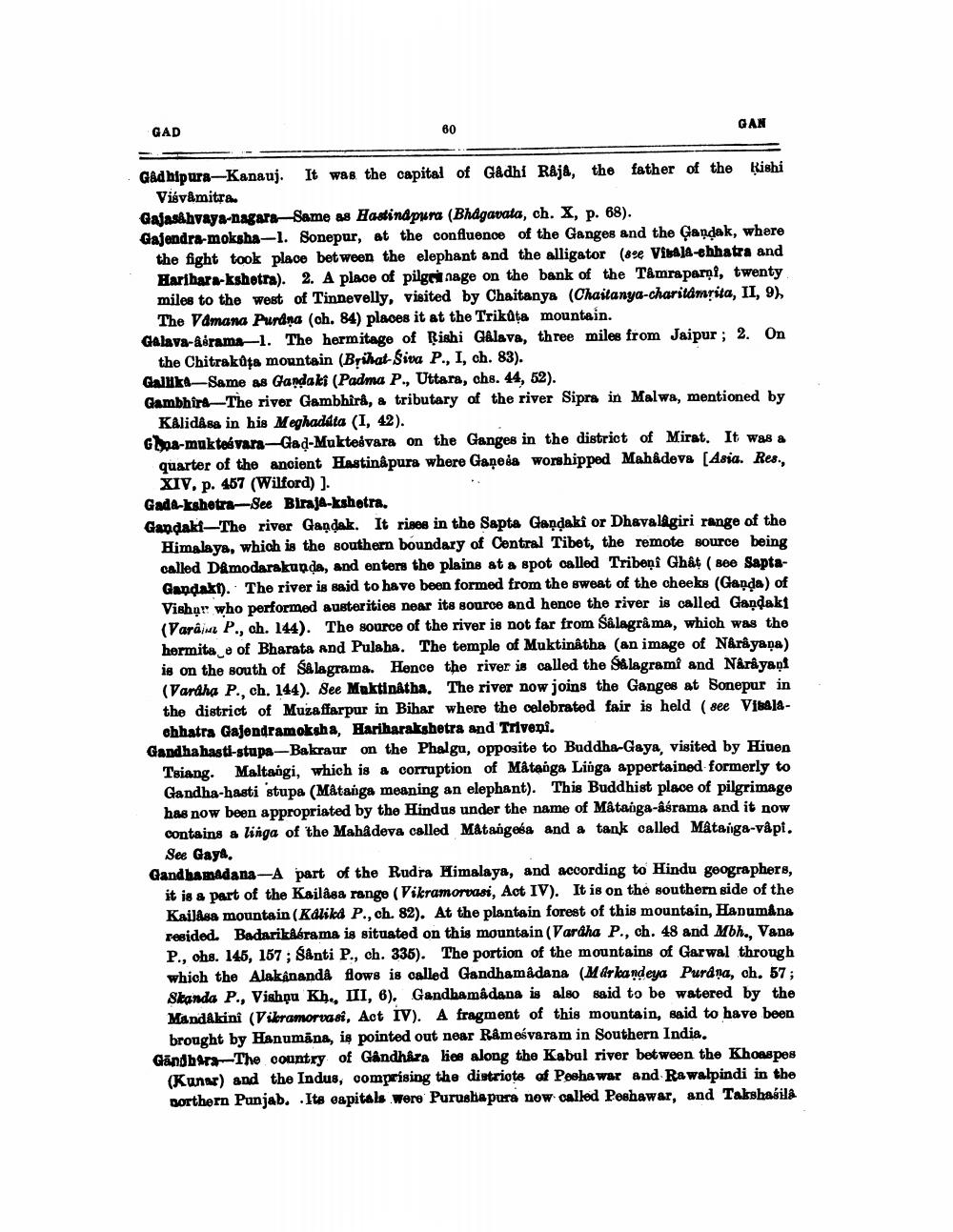________________
GAD
GAN
Gad hipura-Kanauj. It was the capital of Gadhi Raja, the father of the Rishi
Visvåmitra Gajasåhvaya-nagara Same as Hastinapura (Bhagavata, ch. X, p. 68). Gajendra-moksha-1. Sonepur, at the confluence of the Ganges and the Gandak, where
the fight took place between the elephant and the alligator (89e Visaja-ehhatra and Harihara-kshetra). 2. A place of pilgrimage on the bank of the Tamraparni, twenty miles to the west of Tinnevelly, visited by Chaitanya (Chaitanya-charitamrita, II, 9)
The Vamana Purdna (ch. 84) places it at the Trikāta mountain. Galaya-Aérams-1. The hermitage of Rishi G&lava, three miles from Jaipur ; 2. On
the Chitrakuța mountain (Brihat-Siva P., I, ch. 83). Gallike-Same as Gandaki (Padma P., Uttara, chs. 44, 52). Gambhire The river Gambhira, a tributary of the river Sipra in Malwa, mentioned by
Kalidasa in his Meghadáta (I, 42). Ghoa-mukteśvara-Gad-Muktesvara on the Ganges in the district of Mirat. It was a
quarter of the ancient Hastinapura where Ganesa worshipped Mahadeva (Asia. Res.,
XIV, p. 457 (Wilford) ]. Gada-kshetra-See Biraja-kshotra. Gandakı-The river Gandak. It rises in the Sapta Gandaki or Dhavalagiri range of the
Himalaya, which is the southern boundary of Central Tibet, the remote source being called Damodarakanda, and enters the plains at a spot called Triboņi Ghât (see SaptaGandakt). The river is said to have been formed from the sweat of the cheeks (Ganda) of Vishur who performed austerities near its source and hence the river is called Gandaki (Parânz P., ch. 144). The source of the river is not far from Salagrå ma, which was the hermitee of Bharata and Pulaha. The temple of Muktinatha (an image of Narayana) is on the south of SA lagrama. Hence the river is called the Salagrami and N&riyant (Vardha P.ch. 144). See Muktinatha. The river now joins the Ganges at Bonepur in the district of Muzaffarpur in Bihar where the oelebrated fair is held (see VINA]A
chhatra Gajendramoksha, Hariharakshetra and Triveni. Gandhahasti-stupa-Bakraur on the Phalgu, opposite to Buddha-Gaya, visited by Hiuen
Tsiang. Maltangi, which is a corruption of Matanga Linga appertained formerly to Gandha-hasti stupa (Matanga meaning an elephant). This Buddhist place of pilgrimage has now been appropriated by the Hindus under the name of Mâtaiga-asrama and it now contains a linga of the Mahadeva called Måtangesa and a tank called Matanga-väpi.
See Gayt. Gandhamadana-A part of the Rudra Himalaya, and according to Hindu geographers,
it is a part of the Kailasa range (Vikramorvasi, Act IV). It is on the southern side of the Kailasa mountain (Kalikd P., ch. 82). At the plantain forest of this mountain, Hanumana resided. BadarikAbrama is situated on this mountain (Vardha P., ch. 48 and Moh.. Vans P., ohs. 145, 157; Santi P., ch. 335). The portion of the mountains of Garwal through which the Alakanandå flows is called Gandhamadana (Markandeya Purdņa, ch. 57; Skanda P., Vishpu Kh., III, 6), Gandhamádana is also said to be watered by the Mandakini (Vikramorvasi, Act IV). A fragment of this mountain, said to have been
brought by Hanumana, is pointed out near Råmeśvaram in Southern India. Gāndhra-The country of Gandhåra lies along the Kabul river between the Khoaspes
(Kanar) and the Indus, comprising the distriots of Peshawar and Rawalpindi in the Borthern Punjab. Its capitals were Purushapura now called Peshawar, and Takshasila




